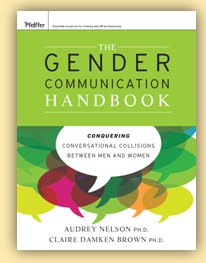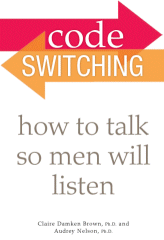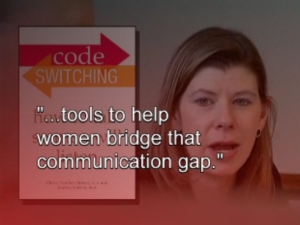From the Playground to the Boardroom: Men, Women and Conflict (Part 2)
1. ___ I played cooperatively and wanted to make sure everyone was included.
2. ___ I played with others by teasing, shoving, pushing, and bantering.
3. ___ I took care of others.
4. ___ I liked taking classmates on and challenging their ideas.
5. ___ I worked for everyone to get along.
6. ___ I ignored and excluded classmates when they hurt my feelings.
7. ___ I told classmates when I was mad at them.
8. ___ I would take a backseat to others.
9. ___ I wanted to be heard when I did not like something.
1. Female. Girls tend to play cooperatively, negotiating relationships to ensure that everyone is included and has a role. Playing “nice” is the goal. A Wall Street (1994, December 5) article talked about awards given to five-year-old kindergarten students in the Midwest (p. B1). The awards designated for the girls were “Biggest Heart,” “Best Helper,” and “All-Around Sweetheart.”
2. Male. In contrast, boys play rougher and louder (ask any elementary school teacher). Boys are more physical.
3. Female. At a very young age, girls exhibit caretaking behaviors. If someone falls and gets hurt, the girls will gather around that person to soothe and comfort them. Social maintenance will be shared among girls, taking care not to hurt feelings or leave anyone out of a game.
4. Male. Boys learn to connect through play banter. Challenging each other is the game boys play out daily on the playground and in the classroom. Boys begin to compete with each other in every arena. Play fighting and challenging is where competitive skills begin to form.
5. Female. Girls are rewarded for social skills, such as getting along well with others and not making waves. Being agreeable, avoiding confrontation, and helping the group cooperate are the goals for girls.
6. Female. When girls get upset with others, they will use social currency as retribution. Ostracizing and excluding others is one of the most common practices among girls.
7. Male. Boys tend to express dissatisfaction and conflict directly. You will hear boys say, “I don’t like you” or “Don’t do that.” It may also be accompanied by a push or shove.
8. Female. Girls will more often acquiesce to others rather than challenge an emerging leader. There is an “alpha” girl type who exhibits dominance, and other girls will quickly defer to her.
9. Male. Often the more a boy objects to something, the louder he becomes. It is common for boys to display dissatisfaction by loud outbursts such as “No,” “Leave me alone,” or “Stop that.”
Taken from Audrey's recently released book (co-author), The Gender Communication Handbook: Conquering Conversational Collisions Between Men and Women (Pfeiffer 2012). |
|
Did
you miss one of the
Smart Talk Columns? |
Browse
the archives of Audrey’s
2006 to date- Smart Talk Columns on her web!
Simply visit www.audreynelson.com and click on “Newsletters.”
|
 |
|
|
Audrey Nelson PhD. is an international trainer, key-note speaker, consultant and author who works with organizations to increase their productivity and profitability through winning communication strategies.
 
Audrey is a member of the American Society of
Training and Development and the Colorado Human Resource Association. |
You can reach Audrey at audrey@audreynelson.com
or at 303.448.1800 O - 303-448-1801 F - 303.448.1802 C
www.audreynelson.com |
Where in the world is Audrey |
 Sherman & Howard L.L.C. Sherman & Howard L.L.C.
Art of Conscious Communication
September 6 Thursday - 11:30-12:30 pm
633 17th St, Suite 3000 -
Denver
Info:
 Credit Union of Colorado Credit Union of Colorado
The Art of conscious Communication
September 11 Tuesday 11:30 am - 12:30 pm
1390 Logan St Denver
Info: Kelly Eargle
 Flatirons Professionals' Network Flatirons Professionals' Network
Ouch! That Hurts: Dealing with Difficult People
September 12 Wednesday
6:00 pm Networking
Outlook Hotel -
800 28th Street -
Boulder
 Cherry Creek Business and Professional Women's Network Cherry Creek Business and Professional Women's Network
Men, Women and Conflict: From the Playground to the Boardroom
September 12 Thursday -
11:00-1:00 pm
Elway's -
2500 East 1st Ave -
Denver
 HUD HUD
Northern Plains Office of Native American Programs
Your Generation or Mine
September 18, 2012 Tuesday - 9:00-10:30 am
Colorado History Center -
13th and Broadway Denver
 MWH Global MWH Global
The Art of Conscious Communication
September 26 Wednesday -
12:00-1:00 pm
370 Interlocken Blvd -
Broomfield
 Cherry Creek Business Women's Network Cherry Creek Business Women's Network
Conquering Conversational Collisions between Men and Women
September 20th Thursday 11am to 1pm
Elway's Cherry Creek
2500 E. First Ave., Denver
Click here to RSVP - more info
 IBM IBM
Men, Women and Conflict: From the Playground to the Boardroom
September 27 Thursday -
4:00 - 5:00 pm
6300 Diagonal Highway -
Longmont
|
|
|
|
|
Have you checked out Audrey’s blog?

Email Showdown - Click for article
Look for Audrey in the September issue of Best Life magazine, a high-end, life style men's magazine. The article, 24-Hour Stress Release , features Audrey as an expert on gender communication and discusses how men can enhance interactions with their spouse or girlfriend.
|

Audrey had an article in the Colorado Human Resource Association newsletter based on her new book (co-author), The Gender Communication Handbook: Conquering Conversational Collisions Between Men and Women
Click here for article
|
| Audrey has been asked to be the guest expert on communication and
Code Switching
for FOX 31 Denver. |
 June 25, 2012 June 25, 2012
Mr. Mom is Back!
Everyday Talk Show Fox 31
KDVR-TV, Denver
Click here for segment |

Audrey was interviewed for the
May
2012 issue of Men’s Health Magazine - Click here for article
|
| IT'S HERE! |
 |
 |

The Gender Communication Handbook
Conquering Conversational Collisions Between Men and Women
Audrey Nelson, Ph.D. and
Claire Damken Brown, Ph.D.
Pfeiffer-An Imprint of Wiley
ISBN 978-1-118-12879-4
The Gender Communication Handbook is for anyone who works with the opposite sex. If you are a part of a management team, in HR, or develop corporate training, this book is a comprehensive guide filled with smart advice, extensive research, self-assessments, and compelling true-to-life case studies. This was written to clarify some of the many questions about gender, how the rules have changed and will help individuals thrive in a more increasingly diverse workplace and find a common language. Successful gender communication is a business mandate.
For more information and ordering, visit TheGenderCommunicationHandbook.com
|
|
|
|












